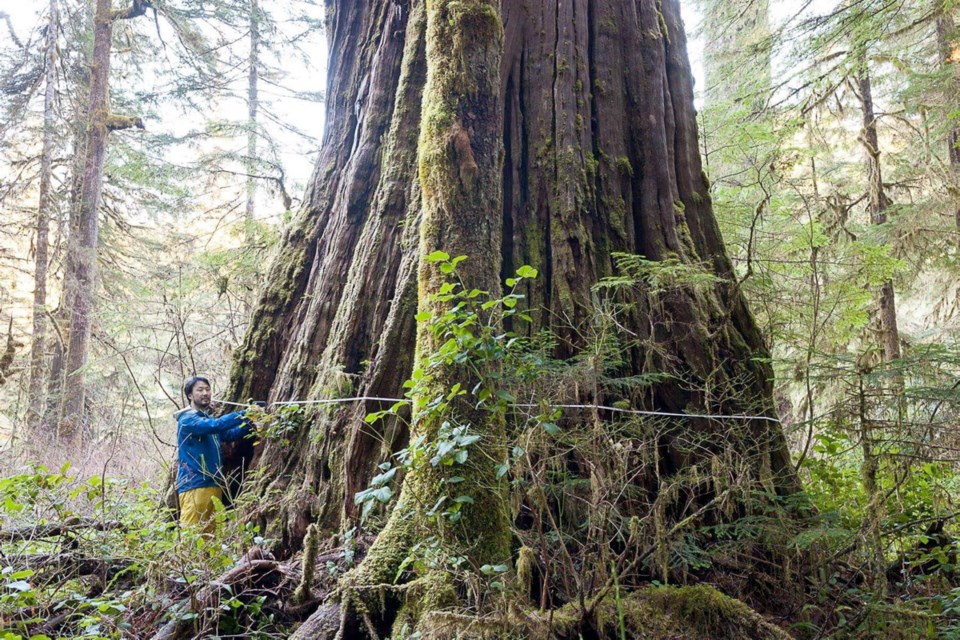The maxim “Justice delayed is justice denied” is nowhere more true than regarding the fate of B.C.’s endangered old-growth forests.
The battle over B.C.’s old-growth forests has been one of the most enduring conflicts in the province’s history. For half a century, hundreds of thousands of British Columbians have placed their time, money, and freedom on the line to protect these globally significant forests, home to trees up to 2,000 years old.
Their unique characteristics require centuries to develop: the immense trees that support tourism and First Nations longhouses, their distinctive structure that supports unique wildlife, and their massive storage of carbon, more per hectare than even the Amazon rainforest. However, under B.C.’s system of forestry, they are to be re-logged every 50 to 80 years, never to become old growth again. Therefore, old-growth logging in B.C. is a non-renewable activity akin to extracting fossil fuels.
This is a time-constrained issue. Already, 80 per cent of the original, productive old-growth forests on Vancouver Island have been logged, including well over 90 per cent of the valley bottoms where the largest trees grow. About 10,000 hectares of old-growth forests are logged each year on the Island, the size of the city of Vancouver, while only eight per cent of the original, productive old-growth forests are protected in parks and Old-Growth Management Areas.
The B.C. NDP’s 2016 pre-election platform created hope for many by promising to “sustainably manage B.C.’s ecosystems, forests and old growth” by “using the ecosystem-based management of the Great Bear Rainforest as a model” — a system that resulted in 85 per cent of the forests there being reserved from logging. However, selective amnesia might have set in, as they have not mentioned their promise since coming to power.
Instead, they have continued with the policies and talking points of the previous B.C. Liberal government, that logging old-growth forests is vital for jobs — which is akin to arguing that we need commercial whaling in order to have food. The fact is that more than 80 per cent of B.C.’s productive forest lands are now second-growth, and the rest of the industrialized world is almost exclusively logging second and third-growth forests.
In addition, the evidence and research shows that protecting nature bolsters the economy by creating and attracting wealth from a diversity of sectors. Protected areas and old-growth forests not only boost the tourism and recreation industries (witness the economic rise of Port Renfrew as Canada’s “tall tree capital,” and the prosperity of Tofino), B.C.’s No. 1 employer, but also enhance real estate values in nearby communities, provide carbon offsets and attract skilled labour such as high-tech workers who locate in communities with a higher environmental quality of life.
However, there are several government initiatives that could finally end B.C.’s “War in the Woods” if the political wisdom exists.
A provincial panel chaired by foresters Gary Merkel and Al Gorley is soliciting public and stakeholder input until Jan. 31 on how to manage B.C.’s old-growth forests, submitting its findings to the province next spring. Now is the time for the B.C. public to fully speak up.
In addition, amendments to B.C.’s forest practices regulations, the Forest and Range Practices Act, will be introduced in the spring of 2020. Public input last spring overwhelmingly favoured amending the act to include science-based targets that would save B.C.’s old-growth forests.
The federal government’s support for increasing Canada’s international commitment to protect 17 per cent of its land base by the end of 2020 to 30 per cent by 2030, is also adding pressure on B.C. to expand its protected areas. Currently B.C. sits at 15 per cent and Canada at 12 per cent protection. The B.C. NDP have yet to support any of these protection targets, which are endorsed by the party’s federal counterpart.
So let’s hope the B.C. NDP government is not simply looking to buy more time with the ongoing “talk and log” processes, with extended timelines, no old-growth logging moratoria anywhere and more vague promises and no action. If they are cynically strategizing to drag this out into a “just elect us in 2021 and then we’ll do the right thing for old-growth forests afterward” plan, they will deserve the same fate as the ancient forests whose demise they are supporting.
Ken Wu is the executive director of the Endangered Ecosystems Alliance and has worked to protect B.C.’s old-growth forests for 28 years.



